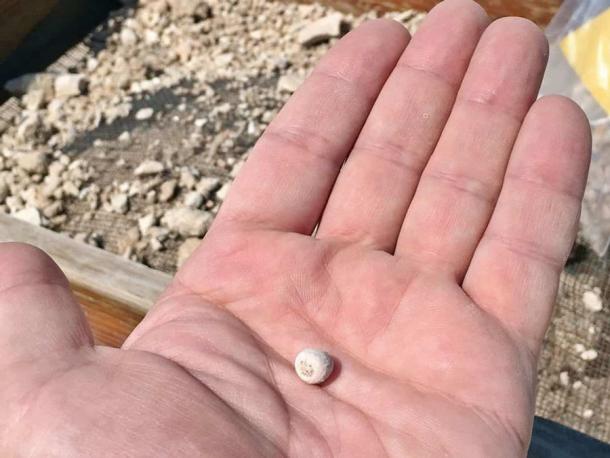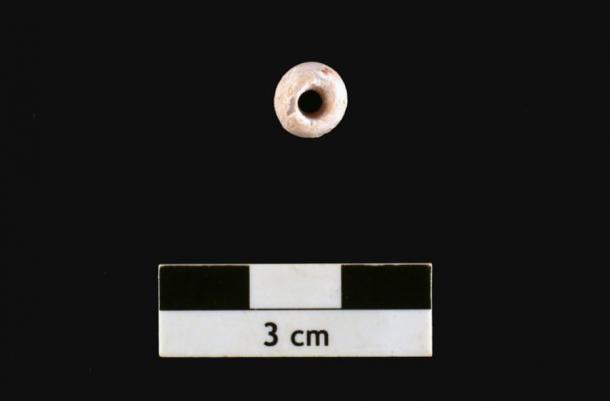
The 6,500-Year-Old Pearl Bead Found in Neolithic Grave in Qatar
In March, 2022, media accounced the discovery of the oldest pearl bead in Qatar, which has a rich history of pearl diving and trade. As reported on by I Love Qatar (ILQ), the archaeological mission, led by led by Ferhan Sakal, Head of Excavation, found the 4,600-BC pearl bead at the one of the oldest Neolithic sites in Qatar.
“Our team has unearthed a find of considerable historical and sociological importance, which points us to the first traceable origins of Qatar’s human settlements and their use of the locally occurring pearl enclaves. With each new remnant of Qatar’s past that comes to light, we gain a clearer understanding of and appreciation for our religious history and identity, which ultimately informs our aspirations for a sustainable future,” said Faisal Abdulla Al-Naimi, author, researcher, and Director of Archaeology at Qatar Museums.

The oldest pearl bead ever found in Qatar, shown here, dates to 4,600 BC! Source: Qatar Museums
The Oldest Pearl in Qatar Revealed More About Pearl Diving
Historical records indicate that Qatar became a pearl trading center as early as the 8th century AD. Much before that, in 2100-1700 BC, small scale bartering of pearls and date palms had already begun in the area. This corresponds with the rise of the Dilmun civilization in Bahrain, whose extensive trade network and relations benefitted their Qatari neighbors. Corroboration of this trading relationship is attested to in the pottery found in sites of both kingdoms.
- Creators of the 800 Al Jassasiya Rock Carvings Remain Undetected
- Archaeologists Discover Rare Seventh century Islamic dwelling in Qatar
During the reign of the Sassanids around the first half of the 3rd century AD, Qatar facilitated the trade of precious pearls. Its geographically strategic position in the Persian Gulf allowed it to flourish and become a center of pearl trading by the 8th century AD, which coincided with the rise of the Abbasids. Evidence of ships from Basra, in Iraq, which were sailing to the emerging eastern empires in India and China, made stops in the ports of Qatar during this period.
Archaeological remains from this period suggest that the profits reaped by Qatari pearl traders allowed for the construction of high quality homes, public buildings, and a developed cityscape. When the Iraqi empire collapsed, the volume of pearl trade greatly diminished, evidenced in the degradation of these Qatari buildings by the 9th century.
In the post-Islamic period, Bahrain and Qatar were seized by the Portuguese in the early 16th century. The Portuguese exported a range of precious items from their Qatari colony in this period and reaped enormous profits, especially from pearls. Qatar’s pearl trade continued to be a primary profit making industry for the Portuguese.
Qatar’s post-Portuguese period is also regularly mentioned in historical records as one of extensive pearl fishing and profit.
In fact, until oil was discovered in the 1940s, pearls were the primary export of Qatar, reported Deccan News. It was very common to go on long voyages on wooden boats known as “dhows,” diving into the sea without oxygen tanks and diving suits to bring up oysters that would yield natural pearls. This wasn’t as straightforward as it seems, as often hundreds of oysters would be opened up to find one solitary pearl.

A closeup of oldest pearl bead ever found in Qatar, from the Neolithic period dated to 4,600 BC, found in a grave at Wadi Debayan, one of the country’s oldest prehistoric sites. (ILQ)
The Wadi Debayan Neolithic Site Has A Long Trade History
The aforementioned pearl bead was found within a grave at Wadi Debayan and was dated to 4,600 BC. Incidentally, Wadi Debayan is one of the country’s oldest Neolithic sites. Apart from an insight into burial practices, the site offers a glimpse into the early settlers on the Qatari peninsula, including their way of life, social hierarchy, and distribution of wealth.
Wadi al Debayan is significant for a number of reasons. Its location on the northwest coastline, a few kilometers south of Al Zubara, put it on the routes of the earliest traders in the region in prehistoric times. Pottery originating from the ancient Mesopotamian Ubaid period, roughly between 6500 BC and 3800 BC, has been discovered at Zubara. Rare obsidian from Anatolia has also been found there.
- Origin of Ancient Egyptian Beads is Out of this World
- Clear Evidence of 4,000-Year-Old Trading Post Unearthed Near Abu Dhabi
The site has been a prominent project of the Qatar Museums, which is conducting year round excavations, field work, and conservation efforts at the site to create a historical and cultural connection between the present and the past.
IB Times reported that the Qatar National Research Fund was providing financial backing to these excavations and projects. The discovery of this jewel is another pearl in Qatar’s glittering past and its prosperous present.
Top image: The oldest pearl bead found in Qatar recently reveals just how long pearl trading and diving has been practiced in the region. (Qatar Marine)
By Sahir Pandey
References
Deccan News. 2022. Archaeologists find more than 6,500-year-old pearl beads in Qatar tomb. Available at: https://deccan.news/archaeologists-find-more-than-6500-year-old-pearl-beads-in-qatar-tomb/
Tribune India. 2022. Archaeologists find over 6,500-yr-old pearl bead in Qatar grave. Available at: https://www.tribuneindia.com/news/schools/archaeologists-find-over-6-500-yr-old-pearl-bead-in-qatar-grave-375309















